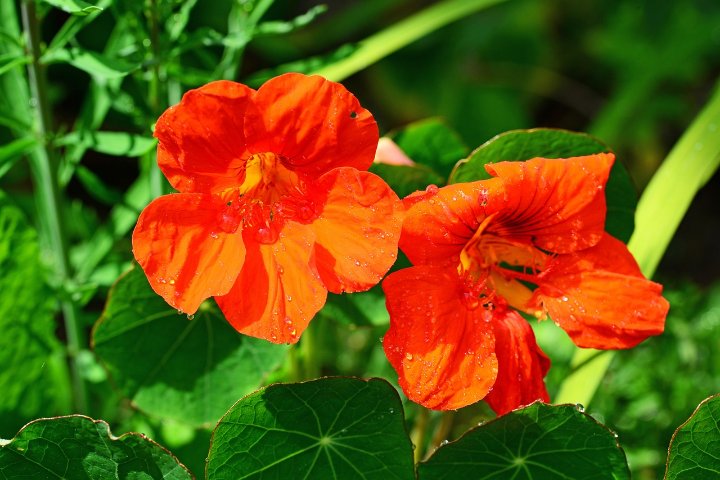Nasturtiums, with their cheerful blooms and trailing vines, are a delightful addition to any garden or landscape. These versatile annual flowers are prized for their vibrant colors, easy maintenance, and edible flowers and leaves.
Best Nasturtium Varieties
| Image | Name | Rating | Shop |
|---|---|---|---|
 | Nasturtium Orange Spitfire |  | |
 | Nasturtium Mahogany Black Velvet |  | |
 | Nasturtium Phoenix |  | |
 | Nasturtium Seeds – Bloody Mary |  |
Nasturtiums Hardiness Zones
Nasturtiums thrive in USDA hardiness zones 9 to 11, where they can enjoy the warm temperatures and mild climates typical of these regions. While they may struggle in cooler climates, nasturtiums can be grown as annuals or container plants in colder regions, providing they are protected from frost.
How Much Sun Do Nasturtiums Need
Nasturtiums thrive in full sun, requiring at least six to eight hours of direct sunlight per day to flourish. Plant them in a location where they can soak up the sun’s rays and bask in its warmth. Adequate sunlight ensures robust growth and abundant flowering throughout the growing season.
Nasturtiums Soil Requirements
When it comes to soil, nasturtiums prefer moist but well-drained soil with a slightly acidic to neutral pH. However, they are adaptable plants that can tolerate a wide range of soil types, including alkaline soils. Amending the soil with organic matter, such as compost or aged manure, can help improve soil fertility and structure, ensuring healthy root development and vigorous growth.
Nasturtiums Plant Spacing
Nasturtium plants can range in height from 1 to 10 feet tall and spread 1 to 3 feet wide, so it’s essential to provide them with ample space to grow and spread. When planting nasturtiums, space them accordingly to allow for adequate air circulation and room for growth. Proper spacing ensures that each plant has enough space to develop fully and produce an abundance of flowers.
Nasturtiums Temperature Requirements
Nasturtiums thrive in moderate temperatures, preferring daytime temperatures in the 70s Fahrenheit. While they can tolerate a light frost, they are not frost-tolerant and will not survive freezing temperatures. Plant them after the danger of frost has passed in the spring and provide consistent temperatures within their preferred range to encourage healthy growth and flowering.
Nasturtiums Fertilizer Requirements
Nasturtiums are light feeders that do not require much fertilization. However, you can apply a balanced fertilizer or a natural soil amendment, such as compost or aged manure, at planting time to provide essential nutrients for healthy growth. Avoid over-fertilizing, as this can lead to excessive foliage growth at the expense of flowers.
Nasturtiums Water Requirements
Nasturtiums require weekly watering to maintain soil moisture and promote healthy growth and flowering. Water them deeply, allowing the soil to dry out slightly between waterings to prevent waterlogged conditions, which can lead to root rot and other moisture-related issues.
Nasturtiums Humidity Requirements
Nasturtiums prefer moderate humidity levels, ranging from 30 to 50 percent. While they can tolerate a wide range of humidity levels, they may struggle in extremely dry or humid conditions. Provide proper air circulation around the plants and avoid overcrowding to reduce the risk of fungal diseases and promote healthy growth.
Nasturtiums Pests and Diseases
While nasturtiums are relatively pest and disease-resistant, they can occasionally encounter issues with pests such as aphids. Additionally, they may develop bacterial leaf spot, a fungal disease that thrives in warm, humid conditions. Monitor your plants regularly for signs of pest infestations and diseases, and take appropriate measures to control them, such as using insecticidal soaps or fungicides.
In conclusion, growing and caring for nasturtiums is a delightful and rewarding endeavor that allows gardeners to enjoy the beauty and versatility of these charming flowers. By providing full sun, moist, well-drained soil, and regular watering and fertilization, you can cultivate healthy and vibrant nasturtium plants that add color and interest to your garden. With their edible flowers and leaves, nasturtiums are not only beautiful but also functional, making them a valuable addition to any garden or landscape.














